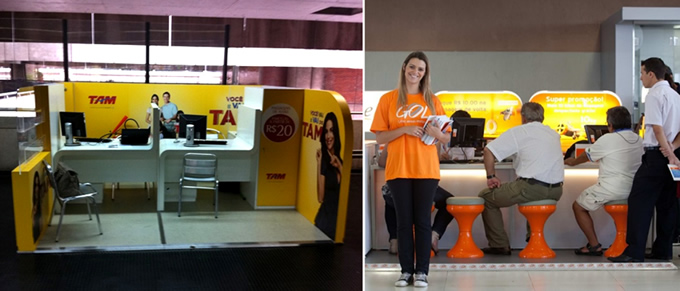Brazil, the largest South American country, has recently enjoyed a tremendous growth of its middle class, resulting in increased demand for aviation.
In fact, the Brazilian middle class grew from 30 percent of the population in the 1960s and ‘70s to 55 to 60 percent in 2011.
In 2010, the lower-middle class accounted for 34 percent of domestic tourism, almost double that of 2002. In the last 10 years, the demand for air travel in Brazil has increased by 194 percent. Much of this increased demand comes from the members of the new Brazilian middle class, many of whom are entirely new to air travel. TAM estimatedthat in 2011 there were going to be 10.7 million first-time flyers.
Brazil’s airlines have been developing innovative strategies as they compete to win over this new market. In the past, airlinetrends.com discussed marketing strategies adopted by TAM to target this first-time flying segment. TAM, and its low-cost competitor GOL, have continued to target the emerging middle class with novel sales channels, including sales kiosks at subway and bus stations.
GOL
During 2011, GOL opened kiosks in subway stations where they provide not only information, but also the option to book, change and/or cancel a flight. The first kiosks were opened in Sao Paulo’s Itaquera, Sé and Luz subway stations in March 2011 and GOL subsequently opened additional kiosks in Sao Paulo’s Tatuapé station, Rio de Janeiro’s Central do Brasil station, Porto Alegre’s Estação Mercado do Metrô station, and one in Salvador.
The main goal of this new distribution channel is to engage the new Brazilian middle class in aviation. According to GOL’s Market Vice President, Claudia Pagnano, “The new identity comprises items referring to airports, as well as illustrations showing the main phases of a flight.” In order to provide better service and meet the needs of a ‘typical’ subway user, GOL’s kiosk teams completed 20 days of specialized training courses that focus on the habits of the emerging middle class, selling techniques, and language skills.
TAM
TAM’s first staffed subway station kiosks were opened in August 2011 at Sao Paulo stations Corinthians-Itaquera, Ana Rosa and São Bento. TAM has since opened two more kiosks in Rio de Janeiro’s subway stations Botafogo and Central.
The subway station kiosks are part of TAM’s “new retail project” marketing strategy, which was launched in 2010 with the goal of strengthening TAM’s efforts “to make plane tickets increasingly more accessible to the overall Brazilian population.” According to Paulo Castello Branco, Vice President of Sales and Planning, “Our plan is to have 200 [travel] stores open by 2012. What we want is that the new publics perceive that they can travel with us and will have access to our sales channels.”
Among the first steps in this marketing project was the opening of sales points in Brazil’s well-known retail store, Casas Bahia. TAM’s subway kiosks have benefitted from TAM’s experience with the Casas Bahia sales points. Says Líbano Barroso, president of TAM, “the business model we implemented in the Subway Project was tried and tested at our kiosks at Casas Bahia.”
TAM’s employees working in the subway stations were not just trained to sell tickets, but also to help first-time flyers navigate the system, from learning about financing and booking flights to what time to arrive at the airport, how to check-in luggage, and other logistics of flying.
TAM has also expanded their sales points to include bus stations and has signed agreements with Pássaro Marron, a bus company presently serving 50 cities in the States of São Paulo and Minas Gerais, and with Princesa do Agreste, a bus company serving 29 north-eastern cities. In both cases, TAM agreed to sell the bus company’s tickets at TAM stores in return for selling air tickets at the bus stations. The Pássaro Marron agreement did not last long, however, as the bus company was acquired by TAM’s competitor, GOL.
GOL and TAM both say they plan to continue expanding these channels of distribution, both in more subway stations and through other venues, to target the emerging middle class.

